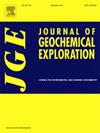Heavy metals' release behavior in antimony tailings dump and its response to different rainfall conditions
IF 3.3
2区 地球科学
Q1 GEOCHEMISTRY & GEOPHYSICS
引用次数: 0
Abstract
Under the influence of natural rainfall, heavy metals (HMs) in Qinglong antimony tailings are easily released into surface or underground runoff, posing a great threat to the ecological environment and human health. In this study, an independently designed rainfall simulation device was used to study the effects of tailings leachate and carbonate rocks on the release behavior and mechanism of HMs under rainfall activities (different rainfall intensities and intermittent rainfall). X-ray diffraction shows that the characteristic minerals of tailings are quartz, gypsum, kaolinite, pyrite, fluorite and calcite, and the main antimony mineral is stibnite. The simulated rainfall shows that lower intensities result in decreased pH, increased EC, higher heavy metal concentrations, and cumulative release amounts positively correlated with rainfall intensity, but has little effect on the leaching mechanism of HMs. The release of Sb is mainly a diffusion mechanism, and the leaching of As, Fe, and Mn is mainly controlled by surface leaching. Intermittent rainfall leaching significantly promoted the release of Sb and As, changing the release control mechanism and increasing concentrations by 109.2 μg/L and 16.6 μg/L, respectively. Carbonate rocks can effectively inhibit release of HMs from tailings while elevating Sb/As/Fe valence states and inducing Sb-As-Fe-Mn release correlations. The kinetic release mathematical model reflects that the release process of HMs is controlled by multiple factors. This work has deepened the understanding of heavy metal leaching under various rainfall conditions and provided a useful reference for managing open-pit tailings in karst mountainous areas.
锑尾矿库重金属释放行为及其对不同降雨条件的响应
在自然降雨的影响下,青龙锑尾矿中的重金属极易进入地表或地下径流,对生态环境和人体健康构成极大威胁。本研究采用自主设计的降雨模拟装置,研究了降雨活动(不同降雨强度和间歇降雨)下尾矿渗滤液和碳酸盐岩对HMs释放行为和机制的影响。x射线衍射结果表明,尾矿的特征矿物为石英、石膏、高岭石、黄铁矿、萤石和方解石,锑矿物主要为辉锑矿。模拟降雨结果表明,较低强度导致土壤pH降低、EC升高、重金属浓度升高,累积释放量与降雨强度呈正相关,但对土壤有机质的淋溶机制影响不大。Sb的释放以扩散机制为主,As、Fe、Mn的浸出主要受表面浸出控制。间歇性降雨淋溶显著促进了Sb和As的释放,改变了释放控制机制,浓度分别增加了109.2 μg/L和16.6 μg/L。碳酸盐岩可以有效抑制尾矿中HMs的释放,同时提高Sb/As/Fe价态,诱导Sb-As-Fe- mn释放相关性。动力学释放数学模型反映了HMs的释放过程受多种因素控制。该工作加深了对不同降雨条件下重金属浸出的认识,为岩溶山区露天尾矿管理提供了有益的参考。
本文章由计算机程序翻译,如有差异,请以英文原文为准。
求助全文
约1分钟内获得全文
求助全文
来源期刊

Journal of Geochemical Exploration
地学-地球化学与地球物理
CiteScore
7.40
自引率
7.70%
发文量
148
审稿时长
8.1 months
期刊介绍:
Journal of Geochemical Exploration is mostly dedicated to publication of original studies in exploration and environmental geochemistry and related topics.
Contributions considered of prevalent interest for the journal include researches based on the application of innovative methods to:
define the genesis and the evolution of mineral deposits including transfer of elements in large-scale mineralized areas.
analyze complex systems at the boundaries between bio-geochemistry, metal transport and mineral accumulation.
evaluate effects of historical mining activities on the surface environment.
trace pollutant sources and define their fate and transport models in the near-surface and surface environments involving solid, fluid and aerial matrices.
assess and quantify natural and technogenic radioactivity in the environment.
determine geochemical anomalies and set baseline reference values using compositional data analysis, multivariate statistics and geo-spatial analysis.
assess the impacts of anthropogenic contamination on ecosystems and human health at local and regional scale to prioritize and classify risks through deterministic and stochastic approaches.
Papers dedicated to the presentation of newly developed methods in analytical geochemistry to be applied in the field or in laboratory are also within the topics of interest for the journal.
 求助内容:
求助内容: 应助结果提醒方式:
应助结果提醒方式:


